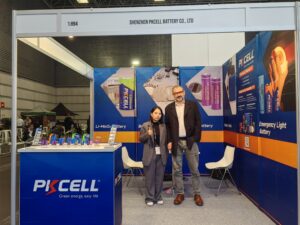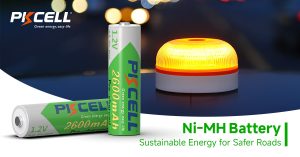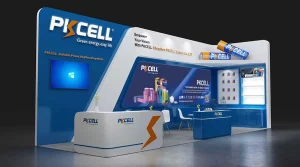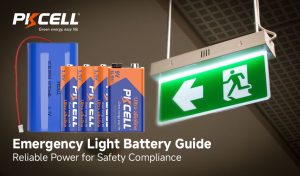
Key Highlights
- Lithium-ion batteries are rechargeable batteries used often in consumer electronics and electric vehicles.
- They offer many benefits over other battery types, including higher energy density, a longer lifespan, and a lighter weight.
- Different types of lithium-ion batteries exist. These include lithium cobalt oxide, iron phosphate, and manganese oxide.
- Good storage and maintenance are crucial to getting the most from lithium-ion batteries.
- Also, knowing the safety precautions for lithium-ion batteries is vital for safe and effective use.
The Basic Knowledge of Lithium-Ion Battery

Lithium-ion batteries have changed the way we use portable electronics. Now, they also power electric cars and renewable energy systems. These batteries can be recharged and are popular because they have high energy density, are lightweight, and last a long time.
Lithium-ion batteries are found in many devices, such as smartphones, laptops, electric cars, and solar power systems. Knowing how these batteries work, the different types available, and their uses can help us understand why they are essential and assist us in making smart choices about using them.
What is a lithium-ion battery, and how does it work?
Lithium-ion batteries are rechargeable batteries that use lithium ions to hold and release energy. When the battery discharges, lithium ions move from the negative electrode (anode) to the positive electrode (cathode) through an external circuit, creating an electric current.
When charging the battery, the process goes in the opposite direction. An outside electrical source pushes the lithium ions back from the cathode to the anode. This back-and-forth movement of ions is what makes lithium-ion batteries rechargeable.
In short, the movement of lithium ions between the electrodes controls how the battery works. This action, caused by electrochemical reactions, allows the battery to change stored chemical energy into electrical energy, which powers devices.
The Structure of Lithium-Ion Battery

The lithium-ion battery is built smartly to help lithium ions move easily. It has several important parts: the cathode (the positive electrode), the anode (the negative electrode), the electrolyte, the separator, and the current collectors.
The cathode is often made from lithium cobalt oxide, iron phosphate, or manganese oxide. It holds lithium ions when the battery charges. On the other hand, the anode is mainly made of graphite. It holds lithium ions when the battery discharges.
The electrolyte is a liquid or gel that helps lithium ions travel between the active materials of the electrodes. The separator is a special material that keeps the anode and cathode apart. It stops short circuits but lets ions flow. Finally, current collectors help electric flow in and out of the battery, which keeps the electrical circuit working.
Discharging and Charging of Lithium-Ion Battery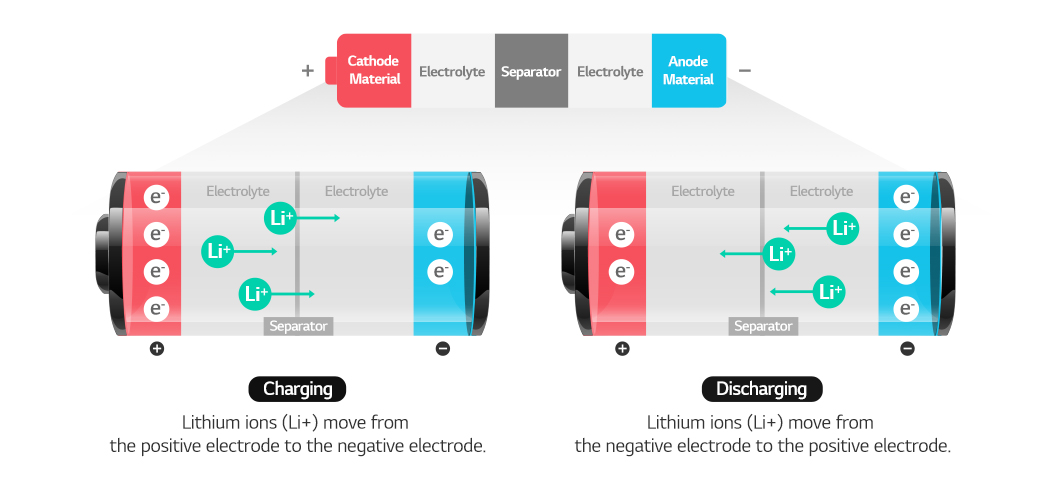
During the use of a lithium-ion battery, like on your smartphone, lithium ions move from the anode to the cathode through the electrolyte. This movement makes an electrical current that powers your device. The discharge rate shows how quickly the battery is used up, while the state of charge tells you how much energy is left in the battery when operating at high voltage.
When you charge a lithium-ion battery, the process changes. Lithium ions move back from the cathode to the anode, which stores the electrical energy as chemical potential energy. The battery’s cycle life refers to how many times it can be charged and discharged before it loses too much capacity.
Common Types of Lithium-Ion Batteries

Lithium-ion battery technology has changed a lot. It now includes many different types of batteries, each with its own special qualities for different uses. Knowing these differences is important to choosing the right battery for your needs.
The most common types of lithium-ion batteries are:
- Lithium Cobalt Oxide (LiCoO2 / LCO)
- Lithium Iron Phosphate (LiFePO4 / LFP)
- Lithium Manganese Oxide (LiMn2O4 / LMO)
- Lithium Nickel Cobalt Aluminium Oxide (LiNiCoAlO2 / NCA)
- Lithium Nickel Manganese Cobalt (LiNixMnyCozO2 / NMC)
- Lithium Titanate (Li2TiO3 or LTO)
Each offers a different mix of energy density, safety, lifespan, and cost.
1. Lithium Cobalt Oxide (LiCoO2)

Lithium cobalt oxide, or LiCoO2, is important for lithium-ion batteries. Its high energy density and voltage make it a good choice for consumer electronics like cell phones and laptops.
Its stable structure helps it perform well. However, batteries with lithium cobalt oxide can overheat and typically last for a shorter cycle life than other materials.
Despite some limitations, the LiCoO2 battery is still one of the most commonly used lithium-ion battery types today and is widely used in various portable electronic devices.
2. Lithium Iron Phosphate (LiFePO4)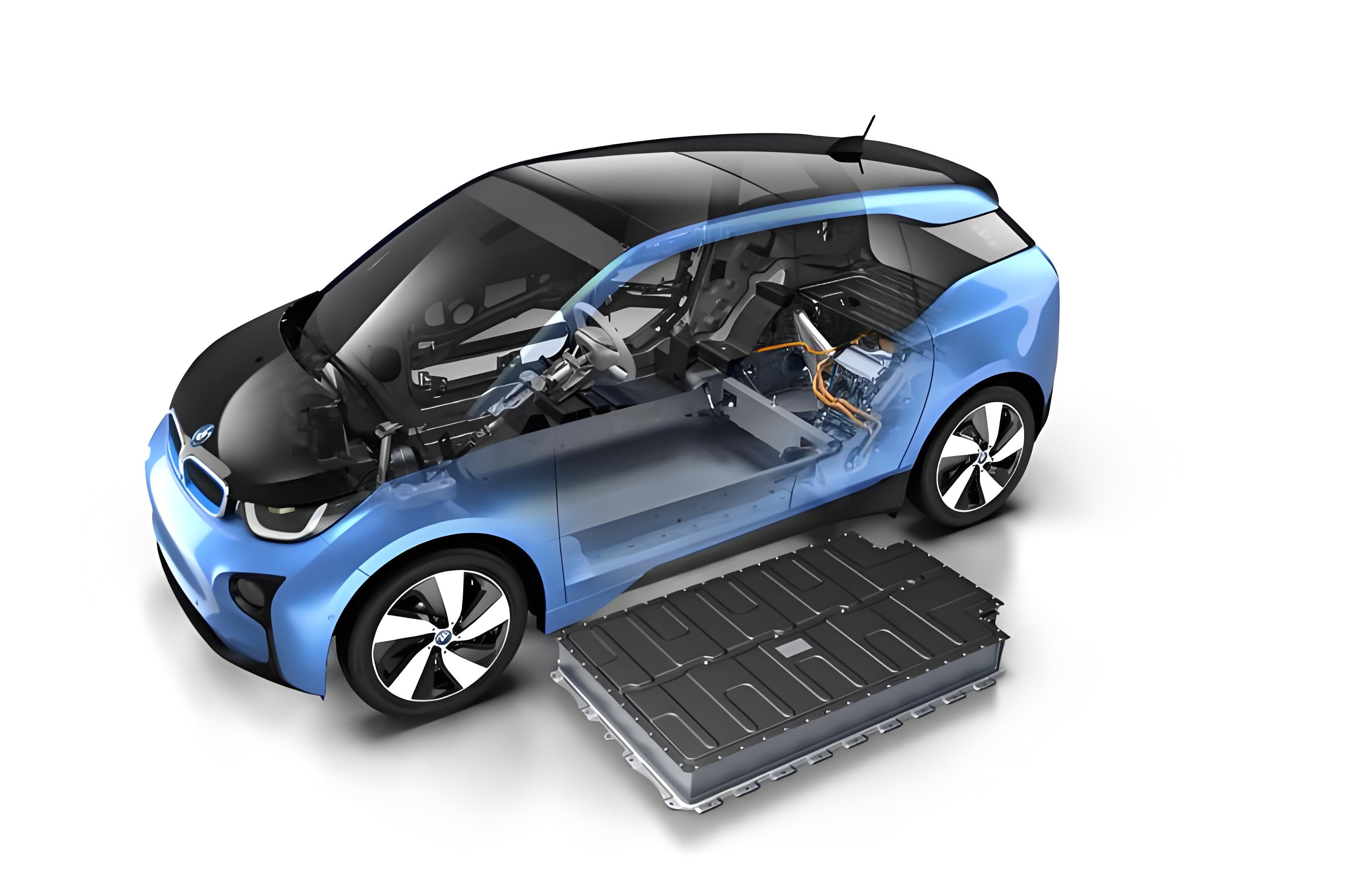
The lithium iron phosphate battery (LiFePO4) is a highly safe lithium-ion battery known for its long cycle life and stability. While its energy density is slightly lower than other lithium-ion batteries, its excellent safety and durability make it ideal for electric vehicles, energy storage systems, and applications requiring high reliability.
LiFePO4 batteries last longer than many other types, making them great for battery management systems that need steady and reliable power. These batteries are also popular because they work well in high-temperature conditions. They have a very stable chemical structure and are less likely to burn or explode, even at high temperatures or overcharges.
3. Lithium Manganese Oxide (LiMn2O4)

Lithium manganate battery (LiMn2O4) is a lithium-ion battery known for its safety and cost-effectiveness. Although its energy density is not as high as lithium cobaltate batteries, its stable chemistry makes it ideal for applications such as power tools and electric bicycles.
It has a high energy density and reliable performance. This compound is often used as a positive electrode in batteries. It helps make the battery more efficient. Its structure allows for fast charging. Also, lithium manganese oxide has a long battery cycle life. This means it lasts a long time and is dependable for different energy storage systems. Its features make it a strong choice for improving future battery technologies.
Applications of Lithium-Ion Batteries

Lithium-ion batteries are everywhere today because they work so well. They are used in many areas, such as powering portable electronics, driving electric vehicles, and storing renewable energy.
These batteries are great because they have high energy density, last a long time, and can adjust to different power needs. Lithium-ion batteries will likely be used even more as technology improves in new areas, such as electric aviation and large-scale energy storage.
Advantages of Lithium-Ion Batteries

Lithium-ion batteries are growing because they offer many benefits compared to other types. They are lightweight, last a long time, have a high energy density, and have a low discharge rate, making them the top choice for many uses.
Thanks to these benefits, we can create smaller and lighter but more powerful devices, electric vehicles that travel farther, and better energy storage systems for renewable energy. Lithium-ion batteries are improving quickly, and ongoing research aims to make them even safer and longer-lasting.
High Energy Density and Efficiency
Lithium-ion batteries are prevalent because they store much energy in a small and light package. This makes them perfect for devices like smartphones, laptops, and electric vehicles, where size and weight are essential.
Having a high energy density means these batteries can run devices for longer. We can use our smartphones for more hours, drive electric vehicles farther, and use renewable energy at home more effectively.
These batteries are also very efficient at charging and discharging. This means they lose very little energy while using or powering devices. As a result, most of the energy stored is used well, which helps extend battery life.
Long Lifespan and Durability
Lithium-ion batteries are well-known for their high energy density and long lifespan. They have a much longer cycle life than other rechargeable batteries. This means they can go through hundreds or even thousands of charge and discharge cycles before their performance drops.
This feature helps devices last longer,, which means fewer battery changes are needed. This leads to less electronic waste and provides good value in the long run. Their sturdy design adds to their durability.
Lithium-ion batteries are made to handle daily use, making them great for many different purposes. They work well in portable electronics that people often use and electric vehicles that deal with harsh driving conditions. Their battery power ability to last under such strains while performing well has made them the top choice in many industries.
Disadvantages of Using Lithium-Ion Batteries

Lithium-ion batteries have many advantages, but we must also consider their disadvantages. Knowing these limitations is important for making smart choices about using them and taking the right safety steps.
Some downsides are safety risks from overheating, the requirement for protective circuits, and their higher cost than other battery technologies.
Potential Safety Risks and Mitigation
While lithium-ion batteries are usually safe if used and handled properly, they can become dangerous if misused or in extreme cases. The electrolytes in these batteries can catch fire, and if they overheat, thermal runaway can occur, potentially causing a fire or explosion.
Lithium-ion batteries often have safety features like a battery protection circuit to lower these risks. This circuit helps stop overcharging, over-discharging, and too much current flow, making hazards less likely.
It’s also essential to follow the manufacturer’s guidelines on charging, storing, and disposing of the batteries. By sticking to these recommendations, you can keep lithium-ion batteries safe and working well for a long time.
Cost Comparison with Other Battery Types
Although the cost of lithium-ion batteries has decreased significantly over the years, they are still more expensive than other types, such as lead-acid or nickel-cadmium batteries. Their manufacturing is complex, and the raw materials used are pricey.
This cost can be a concern for big projects or places where price matters. However, considering their long service life, high energy density, and good performance, they seem more cost-effective.
Over time, their longer service life, lower need for maintenance, and better efficiency can balance out the higher initial cost, making them a good choice for many uses.
Comparative Analysis with Other Battery Technologies
To understand how vital lithium-ion batteries are, we need to compare them with other types of batteries. This comparison helps us see each battery’s strengths and weaknesses, which can help us choose the best battery for our specific needs.
Each type of battery has its benefits. However, lithium-ion batteries usually stand out in many current uses. They have better energy density, a longer lifespan, and more robust performance than other battery technologies.
Lithium-ion vs. Lithium Batteries

Although people often mix the terms “lithium-ion” and “lithium,” they are different. The main difference is in their anode material. Lithium-ion batteries use lithium ions, while lithium batteries use lithium metal, which is very reactive.
This reactivity allows lithium batteries to store more energy. However, it also creates safety risks. Lithium metal batteries can form dendrites, which may cause short circuits and dangerous situations.
In contrast, lithium-ion batteries use a graphite anode, making them safer and more stable. However, they have a slightly lower energy density than lithium metal batteries.
| Feature | Primary Lithium Battery | Lithium-ion Battery |
| Type | Single-Use | Rechargable |
| Anode | Lithium metal | Graphite |
| Energy Density | Higher | Lower |
| Shelf Life | Longer | Shorter |
| Applications | Water meter, electricity meter | Consumer electronics |
Lithium-ion vs. Lead-Acid Batteries

Lead-acid batteries are an old and common type of technology. They are often used in car starters and backup power systems. However, they do not store as much energy as lithium-ion batteries and do not last as long.
This means that a lead-acid battery holds less energy for the same size and has to be replaced more often. Lead-acid batteries charge themselves faster, meaning they lose power over time, even when unused.
On top of that, lead-acid batteries are heavier and larger than lithium-ion batteries. This makes them less ideal for situations where you need something light and easy to carry. Still, lead-acid batteries can be a cheaper choice when weight and size are not as important.
| Feature | Lead-Acid Battery | Lithium-ion Battery |
| Cost | Lower | Higher |
| Energy Density | Lower | Higher |
| Lifespan | Shorter | Longer |
| Maintenance | Require | Free |
| Weight | Heavier | Lighter |
| Safety | Less prone to thermal runaway | More prone to thermal runaway if damaged or mishandled |
| Environmental Impact | Lead is toxic | Green |
Lithium-Ion vs. Lithium Iron Phosphate Batteries

When you look at lithium-ion batteries, you compare two types: lithium cobalt oxide and lithium iron phosphate batteries. Most lithium-ion batteries use lithium cobalt oxide for their cathode. In contrast, lithium iron phosphate (LiFePO4) batteries use a different material for the cathode, which brings its strengths.
For example, lithium iron phosphate batteries last much longer than their lithium cobalt oxide counterparts. This is great for uses where you often charge and discharge, like in electric vehicles and energy storage systems.
On the other hand, lithium iron phosphate batteries have a bit lower energy density than lithium polymer batteries. This means that, for the same size, they might hold less energy than lithium cobalt oxide batteries. Still, lithium iron phosphate batteries’ better safety, longer life, and stability make them an excellent choice for specific uses.
| Feature | Lithium-ion (Li-ion) | Scenarios with high-security requirements |
| Energy Density | Higher | Lower |
| Lifespan | Moderate | Longer |
| Cost | Generally lower | Generally higher |
| Safety | Good | Excellent |
| Applications | Scenarios with high security requirements | Scenes that require high energy density |
How long does a Lithium-ion battery last?

The lifespan of a Lithium-Ion battery is important for its value. It is not just one number. It depends on many things, like how you use it, how you charge it, and where you store it. Knowing these factors can help you make your battery last longer.
Usually, we measure a lithium-ion battery’s lifespan in charge cycles, not years. A charge cycle happens when the battery completely discharges and then recharges. This does not have to be from 0% to 100%. It just needs to add up to a full cycle.
Part 1. What is lithium battery cycle life?
Lithium battery cycle life is how often a battery can be charged and discharged. It usually keeps working until it holds about 80% of its original power, despite the potential for battery degradation. This cycle life is very important for rechargeable batteries, as it tells us how often we can use the battery again before it needs to be replaced.
Many things can affect the cycle life of a lithium battery. These include the type of battery, how you use it, and the temperatures it works in. For example, if you discharge it deeply, it may not last as long as when you only partially discharge it.
Extreme temperatures, whether hot or cold, can make the battery break down faster. This can make the cycle life shorter. Knowing these factors and taking steps to reduce their effect can help you use your lithium batteries longer.
Part 2. What is the life expectancy of a lithium battery?
Cycle life tells us how often a lithium battery can be charged and discharged. In contrast, life expectancy is how long the battery can still work and hold a charge. This is often measured in years and is related to how the battery ages.
Even when you don’t use lithium batteries, they still slowly break down. This happens much slower but can still affect their calendar life. Therefore, even if the batteries haven’t been charged many times, they can still age.
This shows why it is essential to properly store lithium batteries to help them last longer, even when not in use. Things like the temperature you store them at and how charged they are can significantly affect how fast they age and their overall life expectancy.
Part 3. What Influences Lithium Battery Lifespan?
Many things can affect how long a lithium-ion battery lasts. Knowing these things can help you make it last longer and work better. One of the main things is temperature. Very hot or cold temperatures can make the battery age faster.
Hot temperatures can harm the battery parts beyond repair. Cold temperatures can lower the battery capacity and make it harder for electricity to flow. Another critical point is how the batteries are stored.
Keeping batteries at high temperatures or storing them for a long time when fully charged or empty can reduce their lifespan.
How to Choose the Right Lithium-Ion Battery
Choosing the right lithium-ion battery for your needs is very important. It helps with good performance and lasting a long time. Consider several things, like the voltage you need, how much current it can handle, size, and weight limits. These factors help you find the best battery.
Knowing how much power your device needs is key. Look at the energy storage capacity, the discharge rate, and where you’ll use it. This will help you pick the right option.
Understanding Your Power Needs
Before exploring the details of lithium-ion batteries, it’s essential to know your power needs. Battery life and size are very important for portable devices like smartphones. Usually slim, batteries with high energy density work best for these gadgets.
When it comes to devices that need more power, such as power tools or electric vehicles, we look for batteries that provide high currents. These batteries focus on power density to ensure they can give strong energy when needed quickly.
When storing energy, like with renewable energy sources, it’s important to consider storage capacity and cycle life. Batteries should hold a lot of energy from sources like solar panels and manage many charging and discharging cycles.
Considering Size and Weight Constraints
In applications like portable electronics, where compactness and portability are paramount, size and weight constraints become crucial factors in selecting the right lithium-ion battery. Slim and lightweight batteries are highly desirable in smartphones, tablets, and laptops, where every millimetre and gram matters.
Manufacturers strive to balance energy density and physical size, aiming to pack as much power as possible into increasingly smaller packages. This focus on miniaturization has enabled the development of incredibly sleek and powerful devices without compromising battery life.
However, it’s important to note that in specific applications where size and weight constraints are less restrictive, like electric vehicles or grid-scale energy storage, more extensive and heavier batteries might be more suitable to achieve the desired energy storage capacity.
Best Practices for Storing Lithium-Ion Batteries

Proper storage of lithium-ion batteries is very important. It helps keep them alive longer and ensures they are safe to use. By following the recommended storage conditions, you can reduce battery damage, lower the chance of problems, and help them hold a charge better over time.
If you ignore these methods, the batteries can lose their capacity and perform poorly. In extreme cases, this can even create safety risks. Always remember to follow the manufacturer’s storage guidelines. This will help your lithium-ion batteries last longer and work safely.
Optimal Temperature and Humidity Conditions
Maintaining the right temperature and humidity is key when storing lithium-ion batteries. This helps reduce quick wear and makes them last longer. Very high or low temperatures can harm the battery, causing it to lose power and age faster.
The best temperature for most lithium-ion batteries is about room temperature, usually between 20 and 25 degrees Celsius. Avoid keeping batteries in places that experience significant temperature changes, like near heaters, in direct sunlight, or cold cars.
High humidity can also damage battery life by damaging the inside parts. It’s best to store batteries in a cool, dry spot with moderate humidity. Try to keep the humidity between 30% and 50% when possible.
Long-Term Storage Recommendations
Following some tips can help reduce capacity loss and keep lithium-ion batteries that you want to store for a long time working well.
Here are some essential guidelines to remember:
- Partial Charge: Keep the battery charged at a partial level, around 40-60%. This helps reduce stress on the battery and stops it from losing too much charge.
- Cool and Dry Environment: Store the battery in a cool, dry place with steady temperatures and low humidity. Avoid places with extreme temperature changes or lots of moisture.
- Original Packaging: Keep the batteries in their original packaging or use protective cases. This will help prevent short circuits and protect them from outside factors.
By following these tips, you can significantly lessen the impact of long-term storage on your lithium-ion batteries. This will ensure that they are ready to work well when you need them.
Why Choose PKCELL Lithium-Ion Batteries
PKCELL is a top choice for high-quality lithium-ion batteries. We provide batteries for many uses while ensuring their reliability. Our focus on making great products and strict quality checks make us a trusted name in the battery industry.
Our customers care most about performance, safety, and battery longevity. We work hard to meet these needs with every battery we make. Our team of skilled engineers and researchers always looks for new ways to improve battery technology. They ensure that our products keep up with our customers’ changing needs.
Conclusion
In conclusion, it is vital to understand the basics of lithium-ion batteries. This knowledge helps you choose and care for these power sources. We have looked at how they are made, their work, their uses, and their benefits. Remember that you should check your power needs and consider safety. Following the best storage practices is key to extending battery life and getting the best performance. Picking trusted brands like PKCELL for quality and fit can improve your experience with batteries. Take advantage of the efficiency and reliability of lithium-ion batteries for your various energy needs. Remember to follow safety and storage guidelines to get the most out of them.
Frequently Asked Questions
1. Are there any safety concerns associated with lithium-ion batteries?
Lithium-ion batteries are usually safe if you follow the manufacturer’s instructions. Still, there are safety issues, like the risk of overheating. To help reduce these risks, these batteries come with safety features, including a battery protection circuit.
2. How are lithium-ion batteries recycled and disposed of properly?
- To dispose of lithium-ion batteries safely, recycle them at approved facilities.
- Check with your local recycling centre or battery retailers for responsible disposal choices.
3. Is It Safe to Use Aftermarket Lithium-Ion Batteries?
Using aftermarket batteries can be safe, but choosing batteries from trusted brands, such as Pkcell, is better. These should match what the device manufacturer recommends. This way, you can ensure they work well together, stay safe, and keep any warranties valid.
4. Can lithium batteries be used in any device?
No, lithium batteries do not work with every device. You should always check what the maker suggests about which batteries you can use. Using the wrong battery can harm your device or be unsafe.

 USB Rechargeable Lithium Battery
USB Rechargeable Lithium Battery
